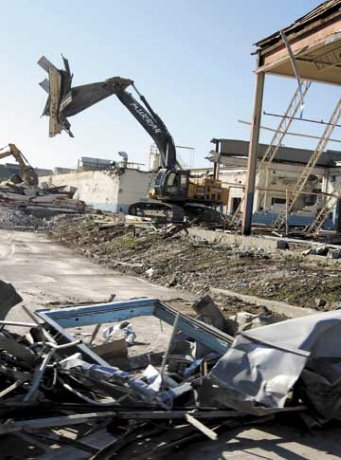General Electric Corp. (NYSE:GE) is closing GE Consumer & Industrial, an Oakville, Ontario manufacturing facility for incandescent, fluorescent and halogen light bulbs. The contract for the environmental abatement and selective demolition of the 300,000-square-foot facility, known locally as the Oakville Lamp Plant, was awarded to Quantum Murray LP (QMLP). One substance that required special consideration was mercury dust that had accumulated on the rafters and other out-of-the-way locations of the building throughout the years,
HazMat Demolition
Asbestos and mercury dust at former General Electric plant
The world market for lighting products has been heavily shaped by government regulation and consumer preference.
The market shift toward energy-efficient bulbs led to the 2009 announcement that General Electric Corp. (NYSE:GE) was closing GE Consumer & Industrial, an Oakville, Ontario manufacturing facility for incandescent, fluorescent and halogen light bulbs. The contract for the environmental abatement and selective demolition of the 300,000-square-foot facility, known locally as the Oakville Lamp Plant, was awarded to Quantum Murray LP (QMLP).
The company began work with the hazardous materials portion of the contract, which involved removal of designated substances from the plant through a variety of methods, which included Type 1, Type 2 and Glovebagging asbestos removal procedures. The building was sealed as a precaution as workers removed asbestos insulation, transite asbestos cement, PCBs, mercury switches and other materials typical of buildings constructed over the history of the plant. Original construction dated back to the 1940s, with other building sections added up until the 1970s.
“Manufacturing some of the light bulbs in the plant required the use of mercury, so the one substance that required special consideration was mercury dust that had accumulated on the rafters and other out-of-the-way locations of the building throughout the years,” says QMLP vice president Joe Batista. “We gave our HazMat workers upgraded training to deal specifically with that substance and vacuumed it up with HEPA vacuums, and then went through it with a fine-toothed comb to ensure that it was all removed effectively.”
The facility consisted of a two-storey office building in the front of the property and a large, one-storey manufacturing facility and warehouse in back.
“The client wanted us to preserve part of the office building and to demolish the remaining part, something we were able to do under the guidance of an engineer hired by GE,says Batista. “We were also requested to ensure that the concrete top slab of the building was left intact.”
QMLP crews prepared the site by repairing the concrete floors, filling any voids and cracks, not only to protect workers against tripping hazards, but also to ensure that no demolition dust settled in uneven areas, and no pooling of water occurred on the floors.
Heavy machinery had already been removed from the site, leaving the demolition crews with a large, empty shell with wide open spaces between supports.
Demolition began on the building’s south end, facing the QEW highway, and moved toward the north.
“The material we removed was fairly typical, including plaster, wood, steel and roof asphalt,” says Batista.
The four-month job began in September and is expected to be completed by Christmas. So far, the site has employed as many as 15 workers and six excavators outfitted with grapples and shears.
“The project was virtually completed in-house,”says Batista. “We used our own hazardous materials division to perform the environmental abatement and even recycled the steel at Thomson Metals and Disposal in Burlington, another of our Quantum Murray divisions.
Although the company owns Thomson Waste Transfer in Hamilton, the contract required QMLP to honour General Electric’s Master Service Agreement with a designated disposal site.
“The biggest challenge of the job was the close proximity of the building to other businesses,” says Batista. “You don’t want clouds of dust affecting your neighbours so we were fastidious about using water sprays for dust suppression. Although the HazMat portion of the job was completed in a sealed environment, neighbouring businesses are unlikely to know the difference between one type of dust and another.”
Another precaution was designed to protect the wetland near the facility. Silt fencing was erected around these areas to protect them during the course of the demolition program.
Batista notes that air sampling around the demolition site through all phases of demolition is now considered appropriate due diligence, to ensure that the effects of the project are limited to the site alone.
“We do a baseline air sampling to determine background conditions, then continue to sample at all phases of demolition until the project is completed,” he says. “Perimeter air monitoring keeps everyone at ease.”



Recent Comments
comments for this post are closed